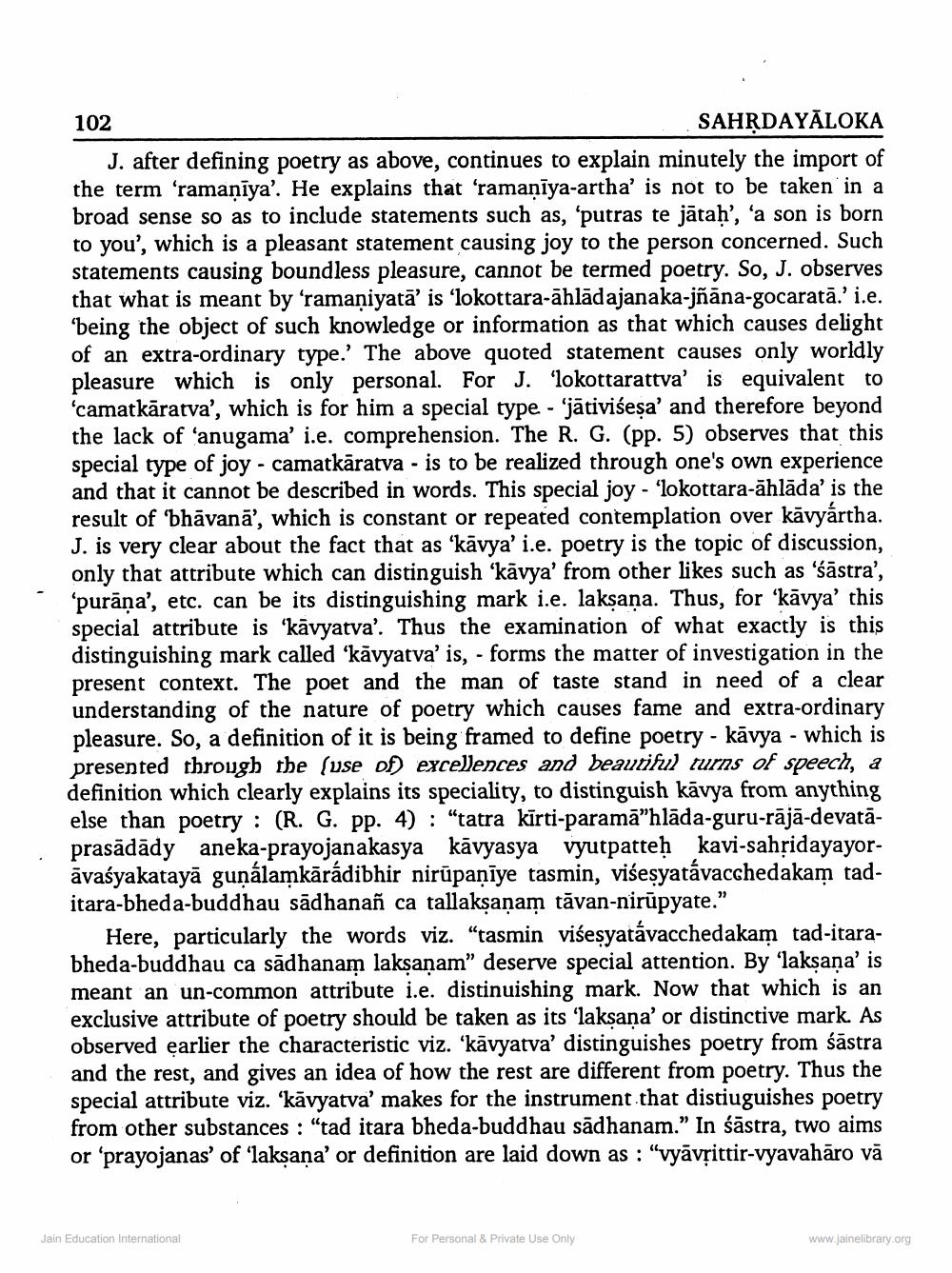________________
102
SAHĶDAYĀLOKA J. after defining poetry as above, continues to explain minutely the import of the term 'ramaniya'. He explains that 'ramaniya-artha' is not to be taken in a broad sense so as to include statements such as, 'putras te jātaḥ', 'a son is born to you', which is a pleasant statement causing joy to the person concerned. Such statements causing boundless pleasure, cannot be termed poetry. So, J. observes that what is meant by 'ramaniyatā' is 'lokottara-āhlādajanaka-jñāna-gocaratā.' i.e. being the object of such knowledge or information as that which causes delight of an extra-ordinary type.' The above quoted statement causes only worldly pleasure which is only personal. For J. 'lokottarattva' is equivalent to 'camatkāratva', which is for him a special type - 'jātivisesa' and therefore beyond the lack of 'anugama' i.e. comprehension. The R. G. (pp. 5) observes that this special type of joy - camatkāratva - is to be realized through one's own experience and that it cannot be described in words. This special joy - 'lokottara-āhlāda' is the result of 'bhāvanā', which is constant or repeated contemplation over kävyártha. J. is very clear about the fact that as 'kāvya' i.e. poetry is the topic of discussion, only that attribute which can distinguish ‘kāvya' from other likes such as 'śāstra', 'purana', etc. can be its distinguishing mark i.e. laksana. Thus, for ‘kāvya' this special attribute is 'kāvyarva'. Thus the examination of what exactly is this distinguishing mark called 'kávyarva' is, - forms the matter of investigation in the present context. The poet and the man of taste stand in need of a clear understanding of the nature of poetry which causes fame and extra-ordinary pleasure. So, a definition of it is being framed to define poetry - kāvya - which is presented through the use of excelences and beautiful turns of speech, a definition which clearly explains its speciality, to distinguish kāvya from anything else than poetry : (R. G. pp. 4) : "tatra kīrti-paramā”hlāda-guru-rājā-devatāprasādādy aneka-prayojanakasya kavyasya vyutpatteh kavi-sahřidayayorāvaśyakatayā gunálamkārádibhir nirūpanīye tasmin, višesyatávacchedakam taditara-bheda-buddhau sādhanañ ca tallakṣaṇam tāvan-nirūpyate.”
Here, particularly the words viz. "tasmin višesyatávacchedakam tad-itarabheda-buddhau ca sādhanam laksanam” deserve special attention. By 'laksana' is meant an un-common attribute i.e. distinuishing mark. Now that which is an exclusive attribute of poetry should be taken as its 'laksana' or distinctive mark. As observed earlier the characteristic viz. ‘kāvyatva' distinguishes poetry from śāstra and the rest, and gives an idea of how the rest are different from poetry. Thus the special attribute viz. 'kāvyatva' makes for the instrument that distiuguishes poetry from other substances : "tad itara bheda-buddhau sadhanam." In śāstra, two aims or 'prayojanas' of 'laksana' or definition are laid down as : "vyavrittir-vyavahāro vā
Jain Education International
For Personal & Private Use Only
www.jainelibrary.org




